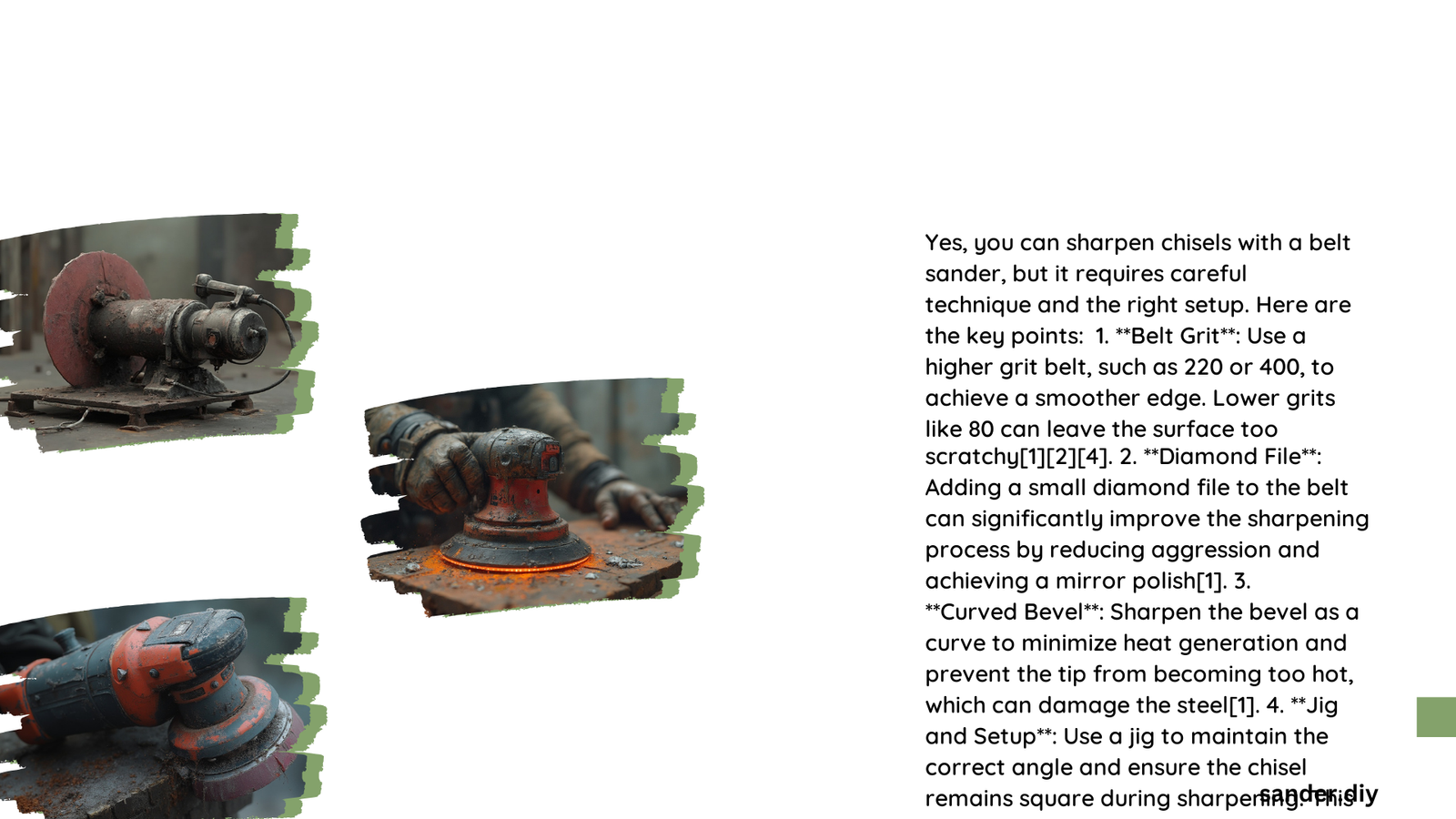Sharpening a chisel with a belt sander is an efficient and effective method when done correctly. This technique requires proper setup, careful attention to angles, and the right grit progression. While it’s possible to achieve a razor-sharp edge using a belt sander, it’s crucial to understand the process and take necessary precautions to avoid damaging your tools or compromising the chisel’s integrity.
What Are the Key Considerations for Sharpening Chisels with a Belt Sander?
Before diving into the sharpening process, it’s essential to consider the following factors:
- Angle consistency
- Grit selection
- Heat management
- Safety precautions
Let’s explore each of these in detail to ensure you can sharpen your chisels effectively using a belt sander.
How to Maintain the Correct Angle When Sharpening?

Maintaining the correct angle is crucial for achieving a sharp and durable edge on your chisel. The ideal sharpening angle for most chisels is between 25 to 30 degrees. Here are some methods to ensure consistent angle maintenance:
-
Use a Jig: Create or purchase a jig that holds the chisel at the desired angle. A simple jig can be made with wooden blocks cut at 25 or 30 degrees, combined with a sliding dovetail track to keep the chisel square.
-
Curved Bevel Technique: Some woodworkers prefer a curved bevel approach. This involves starting the chisel at a slightly higher angle and gradually reducing it as the tip makes contact with the belt. This method can help prevent overheating at the tip.
-
Angle Gauge: Use an angle gauge to periodically check and adjust your sharpening angle during the process.
What Grit Progression Should Be Used for Optimal Results?
Selecting the right grit progression is essential for achieving a sharp edge efficiently. Here’s a recommended grit progression for sharpening chisels with a belt sander:
| Grit Range | Purpose |
|---|---|
| 60-80 | Initial grinding (use sparingly) |
| 120-220 | Main sharpening process |
| 400-1000 | Final polishing |
-
Coarse Grit (60-80): While these grits can be used for initial grinding and removing significant material, they are often too aggressive and can leave deep scratches. It’s generally better to start with a higher grit.
-
Medium Grit (120-220): This range is ideal for the main sharpening process. A 220 grit belt, especially when slightly worn, can produce a very sharp edge. Most of your sharpening time will be spent using this grit range.
-
Fine Grit (400-1000): For achieving a mirror polish, use these higher grits. However, many woodworkers prefer to complete this final step using other tools like oil stones or chromium polishing paste on flat wood.
What Are the Steps for Sharpening a Chisel with a Belt Sander?
Follow these steps to sharpen your chisel effectively:
- Setup:
- Mount your belt sander securely on a stable platform.
- Install a 220 grit belt for the main sharpening process.
-
Prepare your jig or angle guide.
-
Initial Grinding (if necessary):
- If the chisel needs significant reshaping, start with a 120 grit belt.
-
Use light pressure and keep the chisel moving to avoid overheating.
-
Main Sharpening:
- Switch to a 220 grit belt.
- Use your jig or angle guide to maintain the correct sharpening angle.
- Apply light pressure and move the chisel across the belt in smooth, consistent strokes.
-
Lift the chisel off the belt periodically to prevent overheating.
-
Final Polishing:
- For an extra-sharp edge, progress to higher grits (400-1000) on the belt sander.
-
Alternatively, switch to an oil stone or use chromium polishing paste on flat wood for the final polish.
-
Checking the Edge:
- Regularly check the edge for sharpness and consistency.
- Use a magnifying glass to inspect the edge for any irregularities.
How to Prevent Overheating During the Sharpening Process?
Overheating can damage the steel of your chisel, compromising its hardness and edge-holding ability. Here are some tips to prevent overheating:
- Use a light touch when sharpening.
- Keep the chisel moving across the belt; don’t let it rest in one spot.
- Lift the chisel off the belt every few seconds to allow it to cool.
- Have a container of water nearby to dip the chisel in if it gets too hot to touch.
- Use multiple light passes rather than trying to remove too much material at once.
What Safety Precautions Should Be Taken When Using a Belt Sander for Sharpening?
Safety should always be a priority when working with power tools. Follow these precautions:
- Wear safety glasses to protect your eyes from metal particles.
- Use hearing protection, as belt sanders can be loud.
- Ensure proper ventilation to avoid inhaling metal dust.
- Keep your workspace clean and free of clutter.
- Never wear loose clothing or jewelry that could get caught in the belt.
- Always unplug the sander when changing belts or making adjustments.
How Long Should Each Grit Stage Take?
The time spent on each grit stage can vary depending on the chisel’s condition and your desired level of sharpness. Here’s a general guideline:
- Coarse Grit (if needed): 30 seconds to 1 minute
- Medium Grit (main sharpening): 1-2 minutes
- Fine Grit (polishing): 30 seconds to 1 minute
Remember to check the edge frequently and adjust your timing based on the results you’re achieving.
By following these guidelines and practicing your technique, you can effectively sharpen your chisels using a belt sander. This method can save time and produce excellent results when done correctly. Always prioritize safety and take care to avoid overheating your tools during the process.
References:
1. Classical Guitar Delcamp Forum
2. Shopsmith Forum
3. YouTube – Sharpening Chisels On A Belt Sander
